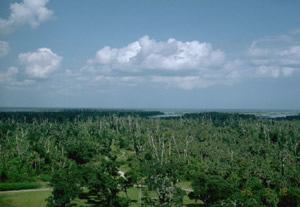|
IMPROVE photos of Cape Romain National WIldlife Refuge in South Carolina, poor visibility is shown by placing mouse over image. |
Refuges Class I Units PDF (126KB)
Class I refuges rated by pollution threat PDF (94 KB)
National Park Service Air Resources Website
EPA Wildland Fires Issues Group
National Atmospheric Deposition Program (NADP)
Interagency Monitoring of Protected Visual Environment (IMPROVE)
Interagency Workgroup on Air Quality Modeling (IWAQM) PDF (3.19 MB)
The Mission of the U.S. Fish and Wildlife Service’s Air Quality Program is to protect and enhance air quality in
support of ecosystem management in the National Wildlife Refuge System.
Our Vision is a Refuge System free of impacts from human-caused air pollution and is consistent with the Refuge System Improvement Act, which requires that:
"…the biological integrity, diversity, and environmental health of the [Refuge] System are maintained…"
More than 550 units make up America's National Wildlife Refuge System, which is dedicated to the protection and preservation of wildlife. Our refuges are committed to conserving natural wildlife habitats, caring for endangered species, and helping Americans enjoy the outdoors. Proper management of air resources is vital to protecting and maintaining Fish and Wildlife Service (FWS) resources.
Pursuant to the Clean Air Act, as amended in 1977, the Service has an affirmative responsibility to protect air quality related values on national wildlife refuges, with special emphasis on Class I Wilderness Areas (areas in excess of 5,000 acres formally designated as Wilderness prior to August, 1977). Congress gave the U.S. Fish and Wildlife Service (FWS), a Federal Land Manager (FLM) of Wilderness Areas, the responsibility to protect the air quality and natural resources, including visibility, of the area from man made air pollution. Polluted air injures wildlife and vegetation, causes acidification of water, degrades habitats, accelerates weathering of buildings and other facilities, and impairs visibility.
![]()
Fish and Wildlife Service responsibility is addressed primarily by the staff of the Division of Refuges Branch of Air Quality (BAQ), located in Denver, Colorado. The Branch's activities include:
- Reviewing air quality permits
- Monitoring air quality visibility
- Modeling air quality impacts
- Conducting special studies to evaluate air pollution impacts to resources
- Identifying and inventorying resources sensitive to air pollution
- Providing technical assistance to refuges and regional offices
- Working on prescribed burning issues relevant to air quality
- Providing input on State and Federal policy/regulatory development
- Enhancing public awareness of air quality issues
The BAQ participates in nationwide air quality monitoring and modeling programs:
- The IMPROVE (Interagency Monitoring of Protected Visual Environments) Program coordinates visibility monitoring
- The National Atmospheric Deposition Program (NADP) monitors pollutants in wet deposition.
- IWAQM (Interagency Workgroup on Air Quality Modeling) develops recommendations on modeling analysis techniques for Class I areas.
![]()
The Federal Land Managers' Air Quality Related Values Work Group (FLAG)
FLAG was formed to develop a more consistent approach for Federal Land Managers to evaluate air pollution effects on their resources. Of particular importance is the New Source Review program, especially in the review of Prevention of Significant Deterioration (PSD) of air quality permit applications. The goals of FLAG have been to provide consistent policies and processes both for identifying air quality related values (AQRVs) and for evaluating the effects of air pollution on AQRVs, primarily in Federal Class I air quality areas, but in some instances, also in Class II areas. The FLAG link provided below.
http://www2.nature.nps.gov/air/Permits/flag/flagDoc/index.cfm
![]()
Air Resources Information System (ARIS)
The Air Resources Information System (ARIS) provides information on parks and wilderness areas managed by the National Park Service (NPS) and the U.S. Fish and Wildlife Service (FWS) as well as Inventory & Monitoring (I & M) networks. ARIS identifies air quality related values for Class I air quality areas and provides guidance on analysis for evaluating impacts to air quality related values. ARIS maintains information for 48 NPS Class I air quality areas and 21 FWS Class I areas.
http://www2.nature.nps.gov/air/Permits/ARIS/index.cfm
![]()
FWS Air Quality Branch Contact Information
Staff:
Name |
Area of Expertise |
Phone |
|
Allen, Tim |
Meteorologist / Modeler & |
303-914-3802 |
Tim_Allen@fws.gov |
Bond, Meredith |
Deputy Chief, Branch of Air Quality |
303-914-3808 |
Meredith_Bond@fws.gov |
Collins, Catherine |
Environmental Engineer |
303-914-3807 |
Catherine_Collins@fws.gov |
Gillam, Dean |
Contractor-Reg. Haze Project Technical |
303-914-3805 |
Dean_Gillam@fws.gov |
Lyon, Linda |
Air Quality Liason |
703-358-2381 |
Linda_Lyon@fws.gov |
Silva, Sandra |
Chief, Branch of Air Quality |
303-914-3801 |
Sandra_V_Silva@fws.gov |
Webster, Jill |
Environmental Scientist |
303-914-3804 |
Jill_Webster@fws.gov |
Wang, Gary |
Contractor-Reg. Haze Project Coordination |
303-914-3803 |
Gary_Wang@fws.gov |
Mailing Address:
UNITED STATES DEPARTMENT OF THE INTERIOR
U.S. Fish and Wildlife Service
National Wildlife Refuge System
Branch of Air Quality
7333 W. Jefferson Ave., Suite 375
Lakewood , CO 80235-2017


